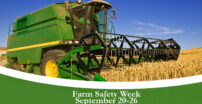Keep farm safety top of mind during fall harvest and beyond.
It’s just about time to reap the reward of a year’s worth of hard work. For Farm Safety and Health Week, September 20–26, 2015, we gathered tips to help keep you and your family in good health during fall harvest and beyond.



